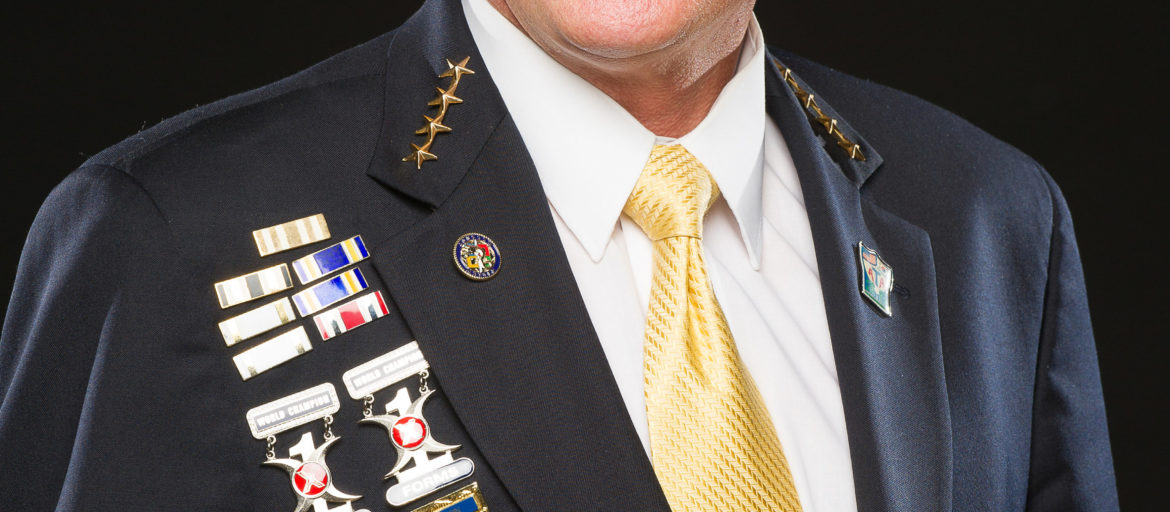Fundamentals of ATA Curriculum Part 3
Written by Bill Babin Motivational Speaker on February 14, 2011
What about all the rest? Weapons, sparring, self-defense, breaking, leadership?
Although the Songahm forms help us to organize most of the Taekwondo curriculum, what about weapons, sparring, self-defense, and leadership? (In the interest of brevity, I will only discuss WEAPONS in this issue.)
Every instructor faces the challenge of ORGANIZING all this additional material so that there is a progression from beginner to intermediate to advanced to black. Although THE WAY videos and books provide details for color belt forms and for black belt forms and weapons, you will need to create your own structure for color belt weapons. Here are the questions you need to ask for all three levels: BASIC, INTERMEDIATE, ADVANCED:
- What are the basics of the weapon?
- What form—if any—or combinations are done?
- What target drills and/or partner exercises are needed?
- How does what you are teaching fit into tournament competition?
- How does it differ from what you are teaching in leadership?
And the most important question of all. . . .
How does the color belt material prepare them for being 1st degrees and 2nd degrees?
I used to think that because a sseong jul bong “flip” was in the 1st black weapon form that color belts could not practice that move. After all, it is part of black belt material. Shouldn’t it be done only by black belts. And if everybody does it, then what is special about being a black belt?
Well after many years of trying to teach that move to black belts with NO EXPERIENCE doing it as a color belt, I finally decided to start teaching it to color belts. In fact, our curriculum now breaks that move into several parts and begins teaching parts of it to WHITE BELTS!
Have any of you had a similar experience?
Color belts learn the basics of black belt material
That is the simple solution. Color belts should practice all of the black belt movements for most of the weapons (SJB, BME, JB) in some basic form. In this way, when they become black belts, these students have experience with the basics and combinations and can begin learning the black belt forms.
Personally I do not include SWORD or SSANG NAT in the color belt curriculum because I reserve those for LEADERSHIP students. So color belts can do those weapons if they are enrolled in the leadership program.
The Big Challenge
Because it has been around so long, we take our educational system for granted. Imagine what it would be like if you were building it from scratch! Imagine trying to decide what language skills to teach at age 5, age 9, age 15, age 18. Although our ATA curriculum is not “new,” it is changing often, and since the Songahm forms were introduced in 1983, we have added NINE weapons, empty-handed combat like joint manipulation, PPCT, and even MMA; we’ve added self-defense/combative/boxing techniques, and a specialized leadership/instructor curriculum; we’ve added life skill instruction, a “personal safety” curriculum, and ATA Xtreme!! WOW!!!
Have YOU kept up with all of this? Have YOU integrated at least a few—if not MOST–of these other elements into your program? Don’t feel bad if you haven’t. Help is readily available. Attend any classes offered by ATA’s TRAINING DIVISION, establish your own instructor network, keep reading this newsletter for more info, or contact me directly at therubbadrumma@cox.net.
Transitions and Connections and Planners
The “final element” to consider in building your curriculum is what I call “transitions and connections.” Here’s a brief look at how the parts of my curriculum work together.
PART 1: Tiny Tigers – Karate Kids – Adults:
These three ideas are the basis of the AGE portion of my curriculum. Tigers range from around age 3 to age 7. Karate Kids from around age 7 to 13, and adults from 13 and up. Note that I said “around” because students transition from one group to the other on an individual basis and upon recommendation by the instructor. Also remember that I recommend that TIGERS advance no higher than PURPLE BELT and that the TIGER program has ONE PURPOSE: to attract families with preschool kids to your program and prepare them for K4K. (Refer to REACHING FOR EXCELLENCE issue #2 for more detail). Also, remember that my TIGER curriculum is one block behind my K4K curriculum so that when a student transfers, he is doing the same form in K4K that he was doing the previous cycle in TIGERS. One sure way to have a successful ADULT program is guarantee that adults have a true “adult” experience in class. One sure way to ruin your adult program is to have it dominated by teenagers who act like kids. It’s up to you which will happen.
PART 2: Basic – Master Club – Leadership:
Three ideas determine what to teach (subject area)
BASIC: designed only to go up to YELLOW BELT or six months of training. Students learn only basics, simple combinations, basic self-defense and safety, and life skills. A high-energy class designed to build rapport with you new clients and show them the value of training. Students do no target kicking, no breaking, and no weapons.
MASTER CLUB: includes everything we used to call “traditional”: forms, 1-steps, sparring, breaking, target kicking, and three weapons: 1&2 BME, 1&2 SJB, and JB. Prepares students for black belt and beyond.
LEADERSHIP: a specialized curriculum—incuding ATA XTREME– that teaches how to communicate with others (through speech, actions, and dress) and how to work with others. Uses the ATA leadership manuals to emphasize life skills like honor, respect, goals, and so on. Allows the student to earn state and world titles.
PART 3: Beginner – Intermediate – Advanced – Black:
These four concepts also determine what to teach but these are based on skill level, not subject area. For students enrolled in Master Club and/or Leadership.
BASIC: white, orange, and yellow belts, who do Songahm 1,2,3 and basic 1SJB, 1BME, and JB, as well as breaking, target work, 1-steps/sparring, and self-defense.
INTERMEDIATE: camo, green and purple belts who do Songahm 4,5,and In Wha 1 and intermediate level 1BME, 1SJB, and JB, as well as breaking, target work, 1-steps/sparring, and self-defense.
ADVANCED: blue, brown, and red belts who do In Wha 2, Chung Jung 1 and 2, double SJB and BME, and advanced JB, as well as breaking, target work, sparring and self-defense.
BLACK: all black belts, divided into rank groups, following the ATA curriculum shown on THE WAY videos.
Planners
The final element is some kind of written planner / outline that ALL your instructors follow so there is consistency in subject, content, and skill level from class to class.
A recommendation from Michael Gerber
There’s an awful lot of BIG IDEAS here. Don’t be overwhelmed! It’s a good thing. The ATA provides a wealth of information that is ALL GOOD. Here are my recommendations:
- go to ataonline.com and review the offerings from the ATA TRAINING DIVISION. Take these classes regularly, at least twice a year if your school is new.
- build your support network of 2 or 3 other school owners. Meet regularly and compare notes.
- keep reading this newsletter.
- attend seminars offered by ATA legends like, Chief Master Clark, Chief Master Allemier, Chief Master G.K. Lee, Chief Master In Ho Lee, Chief Master Michael Caruso, Chief Master Cesar Ozuna and others like them.
- and finally read this special book, THE E MYTH by Michael Gerber, business expert and consultant. That main point of the book is simple: Success is assured for the person who learns that he must spend more time working on his business than he does working in his business.
Summary: “Curriculum-Based Instruction”
- Your curriculum is tied directly to your VISION—to make the world a better place, one black belt at a time.
- Your curriculum provides a comprehensive educational opportunity, covering not only physical fitness and personal safety, but also life skills, social development, and leadership training.
- Your curriculum provides instruction based upon age and skill level, using some kind of block approach.
- Your curriculum teaches the basics of black material—kicking, punching, and weapons—to color belts so that a new 1st black is well-trained in all the individual movements he is expected to use as a 1st black.
- You curriculum uses some kind of structure—like basic, master club, leadership—to assist in organizing what material is taught in which classes.
- Your curriculum is written—in detail or just in outline form—so that all instructors are “on the same page” and yet still retain the freedom to be creative in their approach.
A special offer!
If you would like some help with your color belt weapons curriculum, just email me and request, “Color Belt BME.” I’ll send you FREE a written version that provides details for BME basic techniques and a simple form for all three levels: WOY, CGP, BBR. As we move forward, I hope to have short video clips available as well.
Upcoming topics:
· “Junior Leadership: Why? How? What?”
- “Fulfilling Eternal Grandmaster’s Vision”
- “What is Sseong Jul Bong ‘to the death’??
- “Making your graduations successful”
- “Helping parents become great Taekwondo supporters”





Vincent Young On February 14, 2011 at 5:22 am
SM Babin,
With regards to the underarm swing in 1BD, I have never incorporated it in my color belt programs or was taught any part of it when I was a color belt. I would agree that it has to be the most common technique the new 1BD has trouble with when learning the SSJB form. Q: Will I incorporate it? A: I don’t know yet. Ask me in about 6 months 😉
My Black Belt Club (BBC) Program entails SSJB & SBME only. At the current time, I require Camo on up to be in at least BBC, as I believe that becoming a 1BD and never having experience with an ATA weapon would not prepare you to even be a 1BR. Nowadays, knowledge of weapons and how to judge them are key to rank advancement in our association.
Master Club (MC) Doubles + JB. Requested to join/but not required by bl/br/red belt. My philosophy prevails here as well: Becoming a 2D and never becoming familiar with doubles or the JB puts one at an extreme disadvantage to those that have. Learning how to complete a line in the DSJB form would possibly take twice to three times as long if one has to learn the drills from scratch.
Similar to you, I reserve the SN, OSD, etc. for Leadership, as they are advanced weapons that require an advanced commitment.
Thank you for the posts Sir. They keep the wheels spinning that get stuck over time.
Vincent Young
Young’s ATA Martial Arts